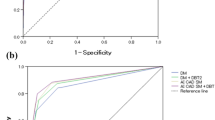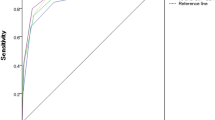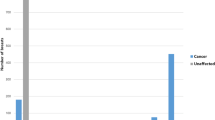Abstract
Objective
To compare the diagnostic agreement and performances of synthetic and conventional mammograms when artificial intelligence–based computer-assisted diagnosis (AI-CAD) is applied.
Material and method
From January 2017 to April 2017, 192 patients (mean age 53.7 ± 11.7 years) diagnosed with 203 breast cancers were enrolled in this retrospective study. All patients underwent digital breast tomosynthesis (DBT) with digital mammograms (DM) simultaneously. Commercial AI-CAD was applied to the reconstructed synthetic mammograms (SM) from DBT and DM respectively and abnormality scores were calculated. We compared the median abnormality scores between DM and SM with the Wilcoxon signed-rank test and used the Bland-Altman analysis to evaluate agreements between the two mammograms and to investigate clinicopathological factors which might affect agreement. Diagnostic performances were compared using an area under the receiver operating characteristic curve (AUC).
Result
The abnormality scores showed a mean difference (bias) of - 3.26 (95% limits of agreement: - 32.69, 26.18) between the two mammograms by the Bland-Altman analysis. The concordance correlation coefficient was 0.934 (95% CI: 0.92, 0.946), suggesting high reproducibility. SM showed higher abnormality scores in cancer with distortion and occult findings, T1 and N0 cancer, and luminal type cancer than DM (all p ≤ 0.001). Diagnostic performance did not differ between the mammograms (AUC 0.945 for conventional mammograms, 0.938 for synthetic mammograms, p = 0.499).
Conclusion
AI-CAD can also work well on synthetic mammograms, showing good agreement and comparable diagnostic performance compared to its application to DM.
Key Points
• AI-CAD which was developed based on imaging findings of digital mammograms can also be applied to synthetic mammograms.
• AI-CAD showed good agreement and similar diagnostic performance when applied to both synthetic and digital mammograms.
• With AI-CAD, synthetic mammograms showed relatively higher abnormality scores in cancer with distortion and occult findings, T1 and N0 cancer, and luminal type cancer than digital mammograms.





Similar content being viewed by others
Abbreviations
- AI-CAD:
-
Artificial intelligence–based computer-assisted diagnosis
- AUC:
-
Area under the receiving operator characteristics curve
- DBT:
-
Digital breast tomosynthesis
- DM:
-
Digital mammogram
- SM:
-
Synthetic mammogram
References
Marmot MG, Altman DG, Cameron DA, Dewar JA, Thompson SG, Wilcox M (2013) The benefits and harms of breast cancer screening: an independent review. Br J Cancer 108:2205–2240
Tabar L, Vitak B, Chen TH et al (2011) Swedish two-county trial: impact of mammographic screening on breast cancer mortality during 3 decades. Radiology 260:658–663
Tabar L, Yen AM, Wu WY et al (2015) Insights from the breast cancer screening trials: how screening affects the natural history of breast cancer and implications for evaluating service screening programs. Breast J 21:13–20
Kerlikowske K, Zhu W, Tosteson AN et al (2015) Identifying women with dense breasts at high risk for interval cancer: a cohort study. Ann Intern Med 162:673–681
Kolb TM, Lichy J, Newhouse JH (2002) Comparison of the performance of screening mammography, physical examination, and breast US and evaluation of factors that influence them: an analysis of 27,825 patient evaluations. Radiology 225:165–175
Mandelson MT, Oestreicher N, Porter PL et al (2000) Breast density as a predictor of mammographic detection: comparison of interval- and screen-detected cancers. J Natl Cancer Inst 92:1081–1087
Ciatto S, Houssami N, Bernardi D et al (2013) Integration of 3D digital mammography with tomosynthesis for population breast-cancer screening (STORM): a prospective comparison study. Lancet Oncol 14:583–589
Friedewald SM, Rafferty EA, Rose SL et al (2014) Breast cancer screening using tomosynthesis in combination with digital mammography. JAMA 311:2499–2507
Skaane P, Bandos AI, Gullien R et al (2013) Comparison of digital mammography alone and digital mammography plus tomosynthesis in a population-based screening program. Radiology 267:47–56
Gennaro G, Bernardi D, Houssami N (2018) Radiation dose with digital breast tomosynthesis compared to digital mammography: per-view analysis. Eur Radiol 28:573–581
Dang PA, Freer PE, Humphrey KL, Halpern EF, Rafferty EA (2014) Addition of tomosynthesis to conventional digital mammography: effect on image interpretation time of screening examinations. Radiology 270:49–56
Bernardi D, Macaskill P, Pellegrini M et al (2016) Breast cancer screening with tomosynthesis (3D mammography) with acquired or synthetic 2D mammography compared with 2D mammography alone (STORM-2): a population-based prospective study. Lancet Oncol 17:1105–1113
Aujero MP, Gavenonis SC, Benjamin R, Zhang Z, Holt JS (2017) Clinical performance of synthesized two-dimensional mammography combined with tomosynthesis in a large screening population. Radiology 283:70–76
Zuckerman SP, Conant EF, Keller BM et al (2016) Implementation of synthesized two-dimensional mammography in a population-based digital breast tomosynthesis screening program. Radiology 281:730–736
Skaane P, Bandos AI, Eben EB et al (2014) Two-view digital breast tomosynthesis screening with synthetically reconstructed projection images: comparison with digital breast tomosynthesis with full-field digital mammographic images. Radiology 271:655–663
Freer PE, Riegert J, Eisenmenger L et al (2017) Clinical implementation of synthesized mammography with digital breast tomosynthesis in a routine clinical practice. Breast Cancer ResTreat 166:501–509
Hardesty LA, Kreidler SM, Glueck DH (2016) Digital breast tomosynthesis utilization in the United States: a survey of physician members of the Society of Breast Imaging. J Am Coll Radiol 13:R67–R73
Gao Y, Babb JS, Toth HK, Moy L, Heller SL (2017) Digital breast tomosynthesis practice patterns following 2011 FDA approval: a survey of breast imaging radiologists. Acad Radiol 24:947–953
Gilbert FJ, Tucker L, Gillan MGC et al (2015) Accuracy of digital breast tomosynthesis for depicting breast cancer subgroups in a UK retrospective reading study (TOMMY Trial). Radiology 277:697–706
Simon K, Dodelzon K, Drotman M et al (2019) Accuracy of synthetic 2D mammography compared with conventional 2D digital mammography obtained with 3D tomosynthesis. AJR Am J Roentgenol 212:1406–1411
Ratanaprasatporn L, Chikarmane SA, Giess CS (2017) Strengths and weaknesses of synthetic mammography in screening. Radiographics 37:1913–1927
Zuckerman SP, Sprague BL, Weaver DL, Herschorn SD, Conant EF (2020) Multicenter evaluation of breast cancer screening with digital breast tomosynthesis in combination with synthetic versus digital mammography. Radiology 297:545–553
Kim H-E, Kim HH, Han B-K et al (2020) Changes in cancer detection and false-positive recall in mammography using artificial intelligence: a retrospective, multireader study. Lancet Digital Health 2:e138–e148
McKinney SM, Sieniek M, Godbole V et al (2020) International evaluation of an AI system for breast cancer screening. Nature 577:89–94
Rodriguez-Ruiz A, Krupinski E, Mordang JJ et al (2019) Detection of breast cancer with mammography: effect of an artificial intelligence support system. Radiology 290:305–314
Benedikt RA, Boatsman JE, Swann CA, Kirkpatrick AD, Toledano AY (2018) Concurrent computer-aided detection improves reading time of digital breast tomosynthesis and maintains interpretation performance in a multireader multicase study. AJR Am J Roentgenol 210:685–694
Rodriguez-Ruiz A, Lång K, Gubern-Merida A et al (2018) Stand-alone artificial intelligence for breast cancer detection in mammography: comparison with 101 radiologists. J Natl Cancer Inst 111:916–922
Bland JM, Altman DG (1999) Measuring agreement in method comparison studies. Stat Methods Med Res 8:135–160
Lawrence I, Lin K (1989) A concordance correlation coefficient to evaluate reproducibility. Biometrics:255–268
Smith A (2016) Synthesized 2D mammographic imaging: theory and clinical performance. Hologic. Available via https://www.hologic.com/sites/default/files/2017/Products/Image%20Analytics/PDFs/C-View-White-Paper.pdf. Accessed 1 Apr 2016
Giess C, Yeh E, Gombos E (2016) Lesion conspicuity on synthetic mammography images compared to full field digital mammography fimages in the screening setting Proceedings of the Radiological Society of North America Annual Meeting, Chicago, IL, USA
Chikarmane SA, Yeh ED, Wang A, Ratanaprasatporn L, Giess CS (2020) Conspicuity of screen-detected malignancies on full field digital mammography vs. synthetic mammography. Acad Radiol 27:757–763
Mariscotti G, Durando M, Houssami N et al (2017) Comparison of synthetic mammography, reconstructed from digital breast tomosynthesis, and digital mammography: evaluation of lesion conspicuity and BI-RADS assessment categories. Breast Cancer Res Treat 166:765–773
Houssami N (2018) Evidence on synthesized two-dimensional mammography versus digital mammography when using tomosynthesis (three-dimensional mammography) for population breast cancer screening. Clin Breast Cancer 18:255–260
James J, Giannotti E, Chen Y (2018) Evaluation of a computer-aided detection (CAD)-enhanced 2D synthetic mammogram: comparison with standard synthetic 2D mammograms and conventional 2D digital mammography. Clin Radiol 73:886–892
Svahn T, Houssami N, Sechopoulos I, Mattsson S (2015) Review of radiation dose estimates in digital breast tomosynthesis relative to those in two-view full-field digital mammography. Breast 24:93–99
Bernardi D, Ciatto S, Pellegrini M et al (2012) Application of breast tomosynthesis in screening: incremental effect on mammography acquisition and reading time. Br J Radiol 85:e1174–e1178
Baldelli P, Bertolini M, Contillo A et al (2018) A comparative study of physical image quality in digital and synthetic mammography from commercially available mammography systems. Phys Med Biol 63:165020
Funding
No funding.
Author information
Authors and Affiliations
Corresponding author
Ethics declarations
Guarantor
The scientific guarantor of this publication is Eun-Kyung Kim, MD, PhD.
Conflict of interest
The authors of this manuscript declare no relationships with any companies whose products or services may be related to the subject matter of the article.
Statistics and biometry
One of the authors has significant statistical expertise.
Informed consent
Written informed consent was waived by the Institutional Review Board.
Ethical approval
Institutional Review Board approval was obtained.
Methodology
• retrospective
• diagnostic or prognostic study
• performed at one institution
Additional information
Publisher’s Note
Springer Nature remains neutral with regard to jurisdictional claims in published maps and institutional affiliations.
Rights and permissions
About this article
Cite this article
Lee, S.E., Han, K. & Kim, EK. Application of artificial intelligence–based computer-assisted diagnosis on synthetic mammograms from breast tomosynthesis: comparison with digital mammograms. Eur Radiol 31, 6929–6937 (2021). https://doi.org/10.1007/s00330-021-07796-y
Received:
Revised:
Accepted:
Published:
Issue Date:
DOI: https://doi.org/10.1007/s00330-021-07796-y




